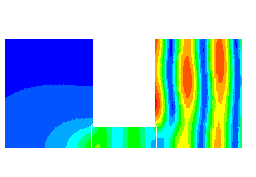
Pressure amplitide distribution at 2250Hz.

Animated pressure amplitide distribution at 2250Hz.
PAFEC VibroAcoustics - Architectural |
|
|
Acoustic finite and boundary elements solve the Helmholtz equations exactly,
within the discretization error. Thus effects such as defraction are naturally
modelled. It is also possible to model interactions with structural objects
such as windows. However, the element size required is proportional to the
wavelength, therefore as the number of elements increases the problem becomes
computationally larger. Thus FE and BE techniques can be used to analyse
'small rooms'
|
|
|

Pressure amplitide distribution at 2250Hz.
|

Animated pressure amplitide distribution at 2250Hz.
|
|
|
Back |
Example: |